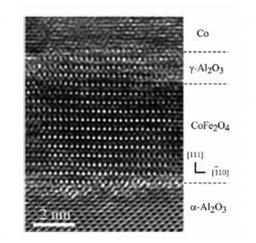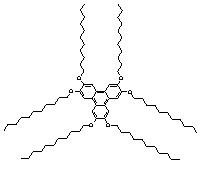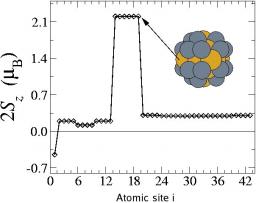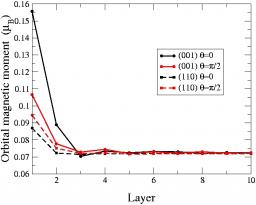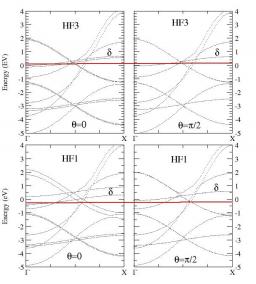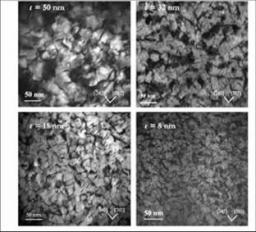Pages scientifiques 2007
The generation of highly spin-polarized electron currents is one of the dominant focusses in the field of spintronics. For this purpose, spin filtering is one very interesting phenomenon, both from a fundamental and from a technological standpoint, that involves the spin-selective transport of electrons across a magnetic tunnel barrier. Successful spin filtering at room temperature could potentially impact future generations of spin-based device technologies not only because spin filters may function with 100% efficiency, but they can be combined with any non-magnetic metallic electrode, thus providing a versatile alternative to half-metals or MgO-based classic tunnel junctions. The spin filter effect originates from the exchange splitting of the energy levels in the conduction band of a magnetic insulator. As a consequence, the tunnel barrier heights for spin-up and spin-down electrons are not the same, leading to a higher probability of tunneling for one of the two spin orientations.
CoFe2O4 is a very promising candidate for room temperature spin filter applications thanks to its high Curie temperature (TC=793 K) and good insulating properties. Electronic band structure calculations from first principles methods predict CoFe2O4 to have a band gap of 0.8 eV, and an exchange splitting of 1.28 eV between the minority (low energy) and majority (high energy) levels in the conduction band , thus confirming its potential to be a very efficient spin filter, even at room temperature. In order to accurately demonstrate the spin filtering capabilities of CoFe2O4 up to room temperature, we have prepared CoFe2O4(111)/γ-Al2O3(111)/Co(0001) fully epitaxial tunnel junctions by oxygen plasma-assisted molecular beam epitaxy (MBE) on Pt(111) underlayers. In this system, the spinel γ-Al2O3 serves to decouple the CoFe2O4 and Co magnetic layers. Before any spin-polarized transport measurements were performed on the full MTJ system, our CoFe2O4(111)/γ-Al2O3(111) tunnel barriers were carefully characterized by a wide range of techniques in order to optimize their structural and chemical properties. Fig.1 shows a high resolution transmission electron microscopy (HRTEM) study demonstrating the high crystalline quality of our CoFe2O4 (5 nm)/γ-Al2O3 (1.5 nm)/Co (10 nm) multilayers. In particular, we observe near perfect epitaxy in the single crystalline CoFe2O4(111)/γ-Al2O3(111) tunnel barrier, which is a consequence of the optimized growth conditions and the spinel structure of both constituents.
Among the many types of liquid crystals (LCs), planar disk-like molecules such as triphenylenes are known to exhibit columnar mesophases. An example of such compounds are 2,3,6,7,10,11-hexakis-alkoxy-substituted triphenylenes, hereafter noted Tn where n indicates the number of carbon atoms in the alkyl chains. Tn molecules consist in flat polyaromatic cores symmetrically surrounded by flexible n-carbon side chains (Figure 1). When deposited on a surface, Tn molecules stack upon each other to form hexagonally packed columns with a p-p stacking configuration. Triphenylene LC mesophases present a quasi-1D transport of charge carriers along these vertical columns which make them attractive for electronic devices applications.
Contact : Christian BETTONI (01 69 08 49 74)
1:
2: Laboratoire Léon Brillouin, CE-Saclay, F-91191, Gif-sur-Yvette, France
3: A. F. Ioffe Physico-Technical Institute,
4:
The properties of magnetics confined in nanometer scale cavities drastically differ from those in the bulk material. The investigation of model materials in the unusual conditions of a so-called “restricted geometry” is of fundamental interest since the confined geometry and the influence of the surface yield unusual properties.
FeNi alloys are widely used magnetic materials. Surprisingly experiments have shown that the magnetic moment per atom in FeNi clusters is much lower than that of the bulk alloy of the same composition [1]. Using a Stoner-like tight-binding model, including spin-orbit coupling, we have calculated the magnetic properties of fcc FexNi1-x clusters (x<0.6) containing up to about 300 atoms for several compositions and three types of chemical order: random and core-shell structures with either Ni or Fe cores [2]. The results show that only the latter type of order is compatible with the observed reduction of moment which can be explained by the existence of an anti-ferromagnetic order in the fcc Fe core (Fig.1)
The magnetic properties (spin and orbital magnetic moments, magneto-crystalline anisotropy energy (MAE)) of nanoparticles, thin films and wires have recently attracted a lot of attention due to their potential applications mainly in the Information Technology sector.
We have carried out a systematic study of the magnetic properties of iron in the tight-binding approximation including s, p, and d valence atomic orbitals taking into account spin polarisation using a Stoner-like model and in the presence of spin-orbit coupling[1]. The validity of the model has first been established by studying in details the magnetic properties of the bcc and fcc bulk phases and comparing the results to those of ab-initio calculations using the PWscf code. This model has then been applied to investigate the (110) and (001) bcc surfaces. The corresponding electronic structures and magnetic moments are very similar to those obtained from ab-initio codes. In addition we have studied the variation of the component of the orbital magnetic moment on the spin quantisation axis as a function of depth, revealing a significant enhancement in the first two layers, especially for the (001) surface (see Fig.1).
Spin electronics is an emerging science which aims at using the spin of the conduction electrons in electronic devices. In a near future, the fundamental mechanisms of spin transport will be affected by some physical limits linked to a further size reduction towards the nanometer scale. It is thus fundamental to understand these limits and more generally the physics of magnetism and transport in reduced dimensions.
Metal-metal nanocontacts are crucial in many areas, but have been poorly investigated from the point of view of local magnetism. This is a very appealing research domain, since local magnetism will greatly influence the (ballistic) conductance across a nanocontact. The break junction technique is a tool that allows the creation of stable (several hours) atomic contacts, which consists in breaking a material in a controlled manner by bending it until eventually a single atom contact appears between the two surfaces. Once a stable configuration is obtained the resistance can be measured as a function of an applied magnetic field. Michel Viret (CEA, SPEC) showed that in magnetic materials such as Fe, Co or Ni, one can obtain large magneto-resistive effects [1].
Among the many types of liquid crystals (LCs), planar disk-like molecules such as triphenylenes are known to exhibit columnar mesophases. An example of such compounds are 2,3,6,7,10,11-hexakis-alkoxy-substituted triphenylenes, hereafter noted Tn where n indicates the number of carbon atoms in the alkyl chains. Tn molecules consist in flat polyaromatic cores symmetrically surrounded by flexible n-carbon side chains (Figure 1). When deposited on a surface, Tn molecules stack upon each other to form hexagonally packed columns with a p-p stacking configuration. Triphenylene LC mesophases present a quasi-1D transport of charge carriers along these vertical columns which make them attractive for electronic devices applications.
Fe3O4 is a very attractive material for applications involving spin-dependent transport at room temperature as this ferromagnetic oxide has a high Curie temperature (Tc= 858 K) and is predicted to be half-metallic. However, the potential applications of Fe3O4 layers in devices relies on the assumption that the magnetic and transport properties in the thin films are similar to those in the bulk material. Several studies have shown that the magnetic behaviour, resistivity, and magnetoresistance strongly deviate from the bulk due to the presence of antiphase boundaries (APBs) in the films. An APB is a stacking fault in the iron cation sublattice which can produce a new magnetic ordering and new magnetic couplings across the APBs. The aim of this section is to analyze rigorously the relationships between the APB density and the anomalous magnetic and magnetotransport properties observed in thin films. Epitaxial Fe3O4(111) thin films of thickness varying from 5 nm to 50 nm were deposited on a-Al2O3(0001) substrates by atomic oxygen plasma-assisted molecular beam epitaxy (MBE). The real time evolution of the film growth was monitored by reflection high-energy electron diffraction (RHEED) in order to verify the high crystalline quality. In addition, in situ X-ray photoemission spectroscopy (XPS), X-ray diffraction, high resolution transmission electron microscopy (HRTEM) measurements and plane view analyses were performed to characterize the structural and chemical properties of the magnetite films of all thicknesses. Figure 1 presents the dark-field images in plane view of Fe3O4 layers of varying thickness. These images qualitatively demonstrate the effect of the film thickness on antiphase domain size, i.e. the decrease in domain size with decreasing film thickness. In order to more quantitatively analyze the evolution of the antiphase domain size as a function of the film thickness, we have shown, in agreement with the work of Eerenstein et al. [1], that this average domain size varies as t1/2, where t is the film thickness. The thickness dependence of the APBs density could be derived from the antiphase domain size and varies as t-1/2 [2], [3]. This direct relationship between film thickness and APBs density has been used to study the influence of such structural defects on magnetic and magnetotransport properties observed in thin films.











